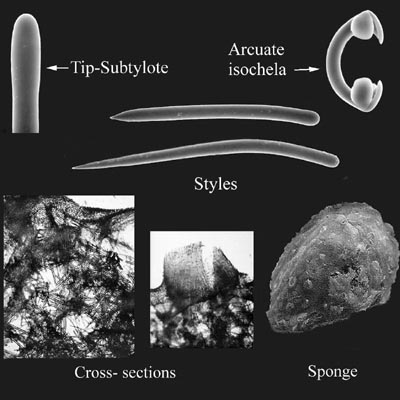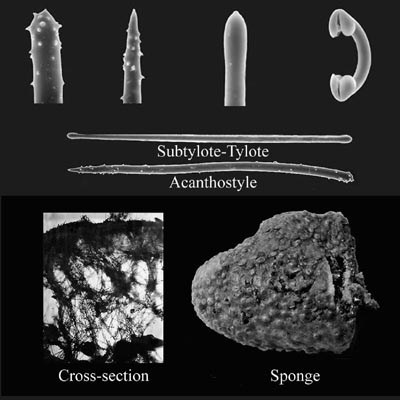[A]
Styles-Acanthostyles 2 size classes.
Arcuate Isochelae: 30 -37-39- 43 μm. |
 de Laubenfels,1930 [of Green & Bakus,1994]
de Laubenfels,1930 [of Green & Bakus,1994] |
Sponge:
Encrusting.
Surface: undulating.
Color: Alive: Pale drab, brown-orange.
Spicules: Megascleres:
(1) Styles:
176 -200-248- 327 um.
x 10 -13-14- 16 um.
Warning: Undefined array key 4 in /home/thackerdb2/public_html/casponges/programfiles/WCS_Key4.php on line 129
(2) Styles:
362 -409-481- 547 um.
x 17 -21-24- 27 um.
Warning: Undefined array key 4 in /home/thackerdb2/public_html/casponges/programfiles/WCS_Key4.php on line 129
(3) Subtylotes- Tylotes:
251 -307-327- 370 um.
x 5 -7- 9 um.
Warning: Undefined array key 4 in /home/thackerdb2/public_html/casponges/programfiles/WCS_Key4.php on line 129
Warning: Undefined array key 3 in /home/thackerdb2/public_html/casponges/programfiles/WCS_Key4.php on line 131
Microscleres:
Warning: Undefined array key 1 in /home/thackerdb2/public_html/casponges/programfiles/WCS_Key4.php on line 195
(1) Arcuate Isochelae:
30 -37-39- 47 um.
Warning: Undefined array key 3 in /home/thackerdb2/public_html/casponges/programfiles/WCS_Key4.php on line 212
Warning: Undefined array key 1 in /home/thackerdb2/public_html/casponges/programfiles/WCS_Key4.php on line 214
Skeleton:
Ectosome: Dermal membrane with Isochelae, below which are Tornotes more or less tangential to the surface.
Choanosome: Dense mesenchyme with ill-defined tracts to surface. These crudely echinated by Styles. The tracts form a loose reticulation.
Distribution: Southern to Northern California.
Depth: Intertidal to deep water.
Note: Bakus, 1966 described this species from Washington and noted the presence of pore seives which do not occur in Lissodendoryx. While this is the most common form seen in California, it may be a different species (Hamigera?) from that described by de Laubenfels. See Page 142A and B.
|
|
[B]
Acanthostyles 1 size class.
Arcuate Isochelae 23 -30- 36 μm.
|

| | Lissodendoryx sp. 3
[of Lee] |
Sponge:
Massive to 5 mm thick and 5.4 mm long.
Fatal error: Uncaught Error: Undefined constant "BConsistency" in /home/thackerdb2/public_html/casponges/programfiles/WCS_Key4.php:294
Stack trace:
#0 {main}
thrown in /home/thackerdb2/public_html/casponges/programfiles/WCS_Key4.php on line 294
| |